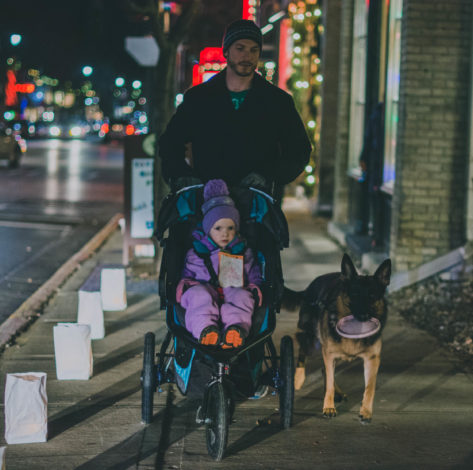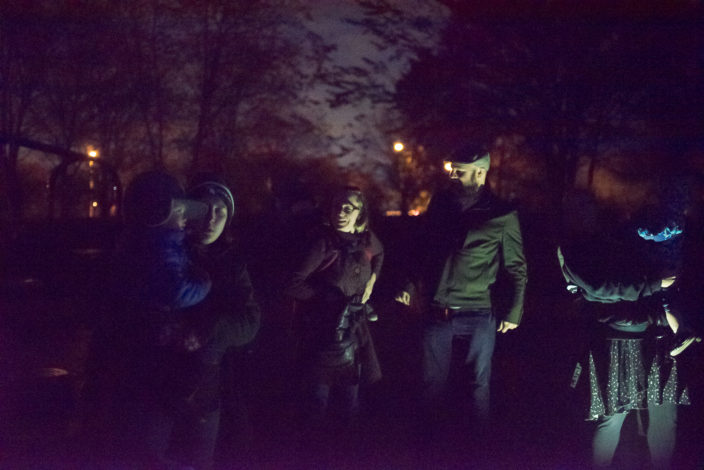8 Unique Ways to Take Advantage of the Long Nights of Winter
This year, Dec. 21, not only marks the first day of winter, but also the winter solstice, which is the shortest day of the year. While those long hours of darkness can make us want to take after the bears and hibernate inside until spring, we have another suggestion for you: Get outside and enjoy it!
Need some ideas? We've compiled a list of fun ways to take advantage of the long nights of winter while making family memories that last a lifetime.
Recommended items to bring on winter night hikes/walks are flashlight/headlamp, extra layers (the temperature can drop rapidly once the sun goes down), warm beverages (such as hot chocolate or cider) and reflective gear (especially if you are walking in areas where you may be close to passing vehicles). In addition, we recommend the newest addition to the BOB stroller lineup: the Revolution Flex Lunar. This unique stroller is outfitted with ultra-reflective fabric to help keep you safe and visible on your early morning and evening adventures. How cool is that?!



1. Sunset Hikes
Longer periods of darkness mean earlier sunset times. This makes enjoying the beauty of a sunset much more feasible for families with young children. (Pre-dinner sunset walk, anyone?) Winter sunsets can occur as early as around 4:30 p.m., whereas a summer sunset can occur as late as 8:30 p.m.!2. Sunrise Hikes
Longer nights also mean later sunrise times. In other words, instead of trying to get the kids ready and out the door before 5:30 a.m. for a summer sunrise, you can wait until around 7 a.m. to catch a winter sunrise. Why not welcome the day on a positive note by getting some fresh air and enjoying a gorgeous, colorful sunrise!3. Full Moon Walks
Full moon walks can be a fun lesson for kids to learn that even though the moon makes no light of its own, it can shine bright by acting like a mirror and reflecting the light of the sun back to us. When the moon is at its fullest, it is receiving light from the sun across its full face, making it shine brightly in the night sky. Not only that, but winter has some of the BEST full moons since the tilt of the earth’s axis has us pointing toward the moon and away from the sun. (Hence, the short days.) This means the moon is up for a long time and takes a high path through the sky. The full moon may even be bright enough for you to be able to turn off your flashlight/headlamp and follow the light of the moon along your walk/hike! There will be a full moon on January 21, 2019. What better way to kick off the year than with a full moon walk or hike?
4. New Moon Walks
I like to call these my stargazing walks. Since moisture can add a hazy appearance to the air, winter is an ideal time to stargaze as cold air is much drier. When you add that to the complete darkness of a new moon, the stars are much more visible and vibrant. Grab a star chart and make it a fun scavenger hunt. Kids can see which constellations they find along the way. The next new moon will fall on January 6, 2019.5. Glow Stick Stroll
Are you struggling to get the kiddos out the door for a nighttime stroll due to complaints of it being “too cold” or “too dark”? Add in some glow sticks and you may see their complaints quickly turn to excitement. Grab some inexpensive glow sticks or glow wands at the dollar store and watch their faces light up as they parade around with their bright colorful accessories!6. Listening Hike
It’s amazing what you can hear at night without the constant distractions and activities that occur in the daytime. Take the family on a night hike on a favorite trail and challenge the kids (and yourself) to close their eyes and just listen for 15-20 seconds. Then ask if they can name what they heard. You may be amazed by what you hear.7. Scavenger Hunt
Make a list of items and critters you may find or hear at night and watch as your kids excitedly explore their surroundings. This can be tailored to the age and ability of the child. For example, younger kids can point out things like an owl, the moon, stars and the sound of night insects. And older kids can draw the shape of the moon, find a constellation, search for a shooting star or airplane, or search for the tracks of nocturnal animals.8. Pajama Walk
After a day full of activity and excitement, kids may not be ready to “call it a night.” That makes the bedtime routine seem endless and full of tears. Winter is a perfect time to change up the routine a bit. With the longer nights, it is almost guaranteed to be dark out around bedtime, so why not take the bedtime story on the road? Get the kiddos ready for bed, with their teeth freshly brushed and pajamas on (along with extra layers depending on where you live), grab a favorite bedtime story (and a headlamp to make reading easy), and head out the door for a bedtime stroll. My little guy especially loves his “Goodnight Moon” walks. We read the bedtime story beloved by many kids and let him say goodnight to the moon, stars, trees, critters etc. By the time we make it back home, he is struggling to keep his eyes open, making the transfer to his bed seamless!Read More:
How do you take advantage of the long nights of winter? Let us know in the comments below! Photos by Jessica Featherstone and Amy Diebold.Related Content




Comments